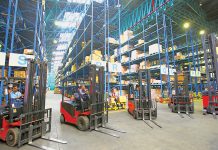With data and technology being termed as the ‘new oil’ in the present pandemic times, efforts are being made to make the supply chain management more visible by staying more positive, agile and fool-proof. ’s digital conclave discussed at length how adopting latest technologies and creating a data bank will make the supply chain industry more visible in the times to come.
Priyanshi Bana
The unforeseen scenarios created by the pandemic has pushed the supply chain and warehousing industries to go full blow for digitalisation. Focussing on the complexities involved in the supply chain sector, CARGOTALK organised a virtual conference discussing the various factors in making the supply chain more visible by enabling it with latest technologies. The session was led by V. Raju, Senior Vice President CL – Chemical, Pharma & Food Sector, Avvashya CCI Logistics (Allcargo Group); Samit Datta, Head – Global Supply Chain, IT, Digital Transformation & Operational Excellence, Piramal Glass; and Huseni Vohra, Director – Business Development, APAC, project 44.
Lessons learnt from the pandemic
With the unexpected dangerous second surge of the pandemic, many lessons have been learnt in order to sail through these worst times. To keep the supply chain moving in a more efficient way, V. Raju said, “The pandemic in all its mighty role has once again hit the businesses and all of us. We thought it to be all over last year. With the second wave, it has totally re-engineered the supply chain management with more focus on e-commerce and retail chain. The meaning of supply chain management has also changed to a great extent. The new supply chain management will be more positive, agile, resilient and will involve quick decision-making. These will be the new hallmarks of the supply chain in the new normal.”
Explaining further, Datta stressed on the 4 R’s which need to be kept in mind for smooth functioning of the supply chain. He said, “The pandemic has been a great revelation in many ways. There are 4 R’s which should be followed rigorously:
- ‘Responsibility’ for everything we do including human safety and in terms of supply chain.
- ‘Responsive’, to create something which is both responsive and resilient.
- ‘Reliable’, the utmost important is the ability to prove ourselves to be reliable to our customers or stakeholders
- ‘Relationships’, should be built more cohesive and able to grow further.
These 4 R’s would play a significant role in the coming times.”
Re-engineering the supply chain
Pointing towards the need to re-engineer the supply chain, Vohra said, “With the pandemic, re-engineering is not limited in the professional world, it is now applicable in all the spheres. We have adapted well in the new normal. The pandemic has had a massive impact on all of us including the trade and global economy. Supply chain has always been a critical function; the pandemic has only magnified the importance of the supply chain in the entire eco system. Thus, the supply chain needs to be more resilient, agile and fool-proof. Technology providers are doing a lot to support the supply chain and offer complete visibility end-to-end.
During a complete lockdown, like many essential services, the supply chain never stopped, supplying the medical essentials, hygiene and cleaning products, food essentials etc., inspite of the huge pressure building on the industry. This pressure was not only from the outside but from within, such as the capacity issues, the demand-supply equations were very dynamic. To top it, the quarantine rules and frequent accidents happening around just added to the problems.
With that said, there is always more room to make supply chain even better. This can be achieved by taking the help of technology adoption on many fronts, visibility being one of them. It is the need of the hour to equip the supply chain with much more intelligence and create a support system which will help in faster decision making. Being an industry leader, many other technology suppliers including project 44 are leading to help the supply chain industry as a whole.”
From globalisation to regionalisation
Explaining the many reasons behind the paradigm shift in the supply chain industry, V. Raju said, “The pandemic has certainly changed the thinking process of the corporates or the customers. The trend is gradually changing from globalisation to regionalisation. Earlier, the stress was on cheap labour, availability of the volumes, better quality and a quicker output because of the surety that the factories, the production centres across the world are running, and the freight costs are cheap and the ships will be available all the time. But the pandemic has changed it all. Today the corporates or an MNC have to take some quick decisions due to uncertainty in the sailing schedules which have taken a hit due to capacity issues, unavailability of the ships all the time due to the pandemic which has hit everyone alike globally. Unavailability of the workforce, goods not reaching on time are some of the key factors which have led to the shift from globalisation to regionalisation. Gone are the days when one thought about cheaper goods, voluminous output etc. We now need to work in an environment close to the factories so that the transportation and travelling schedules do not hit the supply chain and the goods are available well in time.
Similarly, warehousing sector needs to rework upon their locations. The supply chain therefore needs to be more positive, more alert to the changing realms happening around the world. With quick decisions, they should be ready to make heavy investments if required in order to keep the production running. The thinking has totally changed today.
The importance of the regional supply chain is here to stay for some time now. Pandemic or no pandemic, regionalisation will be prevalent till the system reassembles, factories start working and the global supplies return to normal. Till such time, which may even take a few years for the situation to return to a global normal, there will be regional dependency on the supply chain. Thus, regional will be the new norm at least for now.”
Role of technology
Vouching strongly for the immense role technology has played in these tough times, Datta added, “Technology has taken a front seat. In context to India, technology was considered a cost, questioning about the Return on Investments (ROI). However, leading companies have always invested regularly in technology which not only has tangible but also a lot of intangible benefits to it. Tracking the data is the important thing today. Along with this there are a few other elements attached to it such as real time visibility, which will help in taking real-time decisions. Most important is how this data can be used to create some analytics model which can help to predict or prescribe. Therefore, the role played by technology in future will be very high.
Not only this, technology also helps in creating a repository, in terms of knowledge and history. For example, documentation, which is a big aspect in the world of exports and imports, at times can be a big problem if any one document is missing. But once these documents are loaded in a repository which is Cloud-enabled, it becomes convenient for everyone.
Secondly, with this pandemic, a lot of government regulatory bodies have now shifted to electronic data rather than physical documentation, meaning that the world has speeded up and technology has been at the bottom of this change, playing a significant role. Going forward, with more usage of technology, we can use the data to enable us to be more reliable and faster than others.
The real differentiator is going to be data and technology. If we want to survive, we have to adopt it and adapt to it, leaving us with no choice in order to avoid becoming history.”
Explaining further the need of technology, V. Raju said, “Warehouses should be more technology-friendly with Cloud computing, analytics etc. With Warehouse Management System (WMS) software in place, finding out the exact location of the cargo can help to plan our receipts, delivery and inventory management in time and also the remotely controlled operator driven Material Handling Equipments (MHEs) and automatic storage and retrieval systems. These technologies are of great help even during the pandemic times to plan in advance.”
Last-mile delivery
Emphasising on the importance last-mile distribution has acquired in the supply chain management, V. Raju added, “This has become extremely important especially with e-commerce or the online order placement.
There is huge change in the behaviour of the customer as far as the placing of orders is concerned today. Since the orders placed are online, everyone expects a fast delivery within a stipulated time. With the pandemic a lot of orders pile up, as a result supply is unable to keep up the pace. A well-developed Traffic Management System (TMS) can help plan a route optimisation model. Supplying the order through the fastest route available will prove to be a boon. Secondly, contactless and a paperless delivery is a must in saving us from this pandemic.”
True visibility: Need of the hour
Emphasising on the need of true visibility in the supply chain management, Vohra said, “Making the actionable and meaningful data available to the right people in the organisation at the right time is definitely a key.
Once such data and intelligence is available, it should be put to practice in analysing whether one has become more reliable and resilient in their networks based on the data available and is able to bring down its penalties and cost. Another important aspect is to be able to delight their customers with reduced lead time.
As a technology provider, we are trying to help in reducing the detention cost, trying to improve the lead time, trying to trigger the negotiations with the carriers and logistics service providers about the efficiencies and inefficiencies in the trade networks. True visibility is not only about making the data and intelligence available but putting them to practice and using them.”
Congestion, detention, demurrage
Continuing with the role of technology in overcoming such issues, Datta added, “Visibility and technology can help a lot in dealing with such issues. Without them one would land up incurring huge losses. Customising the solutions according to a customer’s requirements with the help of technology will reduce a lot of losses. As far as visibility and working with project 44 is concerned, they have a good triangulation method by which the data is qualified. One important aspect is transhipment, which has often been overlooked.
By virtue of visibility, it is helping a customer in reducing his expenses by keeping track of his vessels. It is helping the customer in a responsible way, enabling them to become confident about one’s supply chain. Technology therefore once again plays a big fundamental role in containing the issues of congestion or demurrage etc.”












